Followers of the Mulography Facebook page may well have seen me mention Buttons once or twice (ha). Medieval games and mounted combat are precisely the kind of thing I dreamed of doing when I got Marty, and so when I found out about Buttons the jousting mule I was thrilled. It meant we had a role model to aspire to!
Unfortunately, as you know, my plans with Marty took a decidedly crooked route and although I haven’t sworn off the idea entirely (Xato would make an excellent caparisoned charger, don’t you think?), I had long since let go of any notion of doing so with my little brown mule.
While talking to David, Buttons’ rider, I happened to mention this and he replied with a fascinating and inspiring story that I just had to reproduce here, in full. It is well worth the read.
“Don’t give up on your mule just yet,” said David. “Mules have a higher self preservation than horses. So it can take some time to teach them that combat activities are just a game and are safe.”
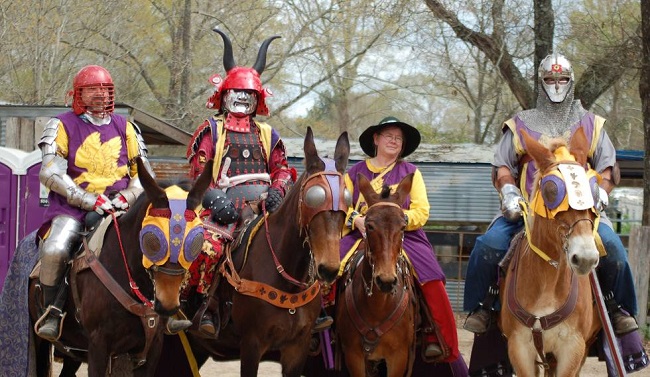
The Story of Buttons
Buttons is a Thoroughbred and Mammoth jack donkey mule cross, standing at 16 hands tall. Buttons has overcome a ton to become one of the top jousting and medieval games equines in the states. Her original owner, who was 2 owners before me, was an old coon hunter who used to beat her between the ears with a board if she made a mistake or brushed him against branches or trees hunting at night. So when she came to me we had a lot to overcome and a lot of trust to rebuild.
I use the term medieval games for any of the SCA games where we hit targets with sword, bow or lance and the term mounted combat for any time we hit another rider with sword or lance. All the mounted combat and medieval games require you to get close to posts or another rider: i.e things that scared her because she was punished brutally for them by that man. And when I picked up a sword she was sure I would hit her with it. Took me many years of building trust to undo that harm.
I started doing the games. We rode a lot of trails and arenas and rewarded her for letting me get close enough to pickup items off posts or touch trees and showed her I could touch stuff from the saddle with my foot or hands and I wouldn’t hurt her. I praised and rewarded her every time she reacted less or let me get closer. I also used every moment we were together as fun training. While she would eat dinner in the stall each night I would hang all over her at first, then I added rubbing her down with my hands and then eventually a sword, all while she ate – even putting treats on the sword blade for her to eventually take off the blade. At first with all these things she would run away to the other side of the stall and freak out. We did a little more each night and didn’t push too far each time. She warred with “I am scared” versus “I want to get on with eating” till she started ignoring my attention and the sword rubbing on her. Then later the sword swinging over her head, then the sword lightly tapping the stall wall, till it was smashing against the stall above and under her on the far wall. Slow escalation of energy over weeks. All this lead to me riding her in games and hitting things with a sword or spear.
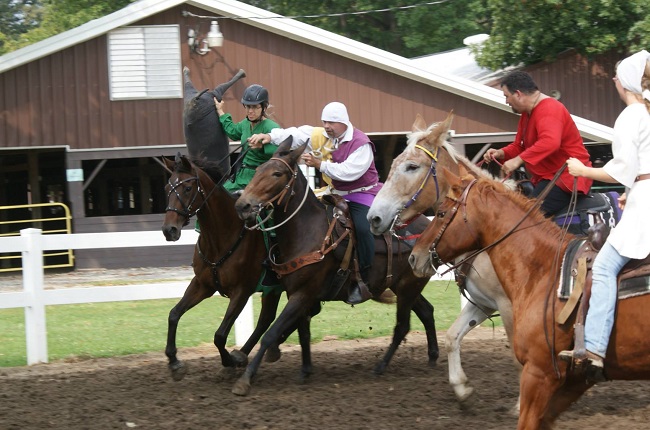
I almost gave up on her a number of times. But there is something about this mule that won my heart early on. Even though for some time we came in last we always got better. She was the first mule I ever rode and I loved her from the start. I knew I could have an easier time riding the other less abused mules we eventually had, but I wanted to ride her and always came back to her. She was always a great a trail mule but I guess I am as stubborn as a mule and wouldn’t give up on her for medieval games and combat.
Archery was another area where I had to overcome her fears. The moment I released the arrow she took off running faster at the sight and sound of the arrow, throwing me off balance and making the next targets in line harder to hit. Back to feed time training. I put a step stool in her stall and while she ate I shot arrows over her back at a target across the barn till she eventually returned to eating and ignored the dumb hairless monkey (pretty sure that’s what she calls me) making weird noises over her back. When we moved to the pasture and on her back shooting, all was then fine.
Jousting had the most to overcome. We had gotten to be a good enough team that we were winning most medieval games contests we entered. And Buttons and I were pretty close when I first tried jousting. My new jousting armor was finished the night I left for the first joust. We ask a lot in jousting. A lance dropping right past her face, running head on at another equine she doesn’t know, a large smash to her rider, the sound of armor and her cantering with a rider.
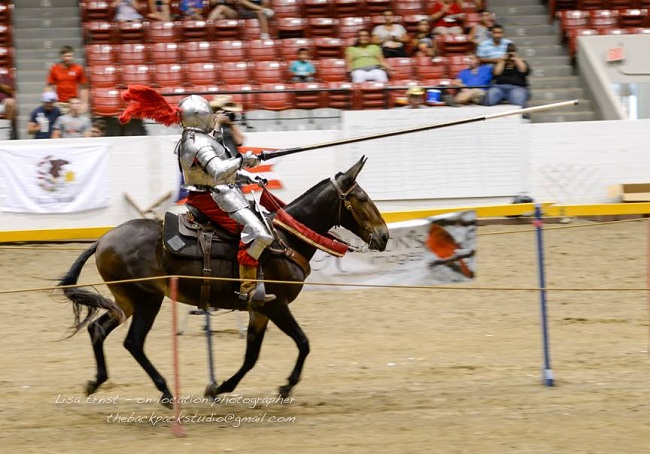
The first time I put heavy jousting armor on and climbed on her back was a cross between a wild mule race and a bucking bronco ride on the devil’s back. My armor didn’t fit me right and it sounded like 2 trash cans being bashed together. The noise was deafening. I realized I had rushed and not given her or I the time or training for this particular task. So I took a huge step back and pulled out of my first chance to do heavy jousting. I went home and fixed my armor to fit me, and padded it to be quieter. I then wore it each night to feed her for months. And at first her eyes went white with fear just seeing me approach her stall in armor. But with food and treats and slow moves and petting we worked past some of the fear.
I can’t take credit for getting her past the next parts. I needed her to canter and not freak out with me on her back in that armor. This mule had never cantered with a rider ever. The two hunters who owned her before me never had need of more than a walk. I had been winning competitions for games for many many years including timed events, but all of that was at her fast extended trot which is faster than some horses canter. However, most jousts will not count your score unless your equine is at a canter through the lance hit. If we wanted to ride in big jousts we needed to canter.
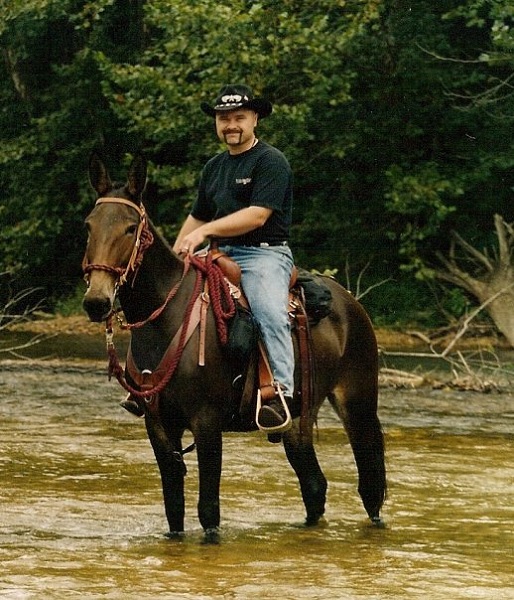
I could not get her to canter. I finally found a teacher locally who is like a cross between a horse whisperer and a Marines drill sergeant. She can watch or ride any animal and tell you what you’re doing wrong and what the animal needs. She also pushes you both a little past your comfort zone every lesson. She got us cantering first lesson, and many lessons after pushed us till we got better at it. Once we could canter we practiced in a fake tilt lane all the things you have to do to joust till Button’s was bored with it and knew her routine. We then put armor on again. Back to white eyes mule and rodeo if I climbed in the saddle. Nothing I couldn’t ride this time, but not the safe quiet mule I was used to and not the state I want her in. I could tell she was about to explode and was scared.
Teacher put us on a lunge line in an arena and told me to make her canter and let go of the reins – just hold on and don’t fall off. So for the next 10 minutes, which seemed an eternity, I was on a runaway mule cantering a circle on a lunge line. At some point Buttons stopped running on her own, sighed really loudly and looked back at me. Teacher said: “That’s what we wanted … we want her to understand she can’t outrun the noise and it’s not going to hurt her.” She then unclipped the lunge rope and in the big open arena said: “Now ride a canter circle by yourself.”
I was a little stunned and a little scared of what might happen in this huge arena. But that hell ride of hanging on while she ran us at a canter on the lunge line was not only good for Buttons, but it showed me my armor was fitting and I can ride a canter as well as I could out of armor. So when she turned us loose that newly earned confidence combined with ‘you don’t fail for this teacher or she makes you do it a hundred more times and finds ways to make it harder to do’ pushed us both to just do it. Once we beat that I could go home and practice each step of the joust routine with Buttons till she knew her job. She is one of the best equines in jousting now. All the way from an abused, scared mule many years before.
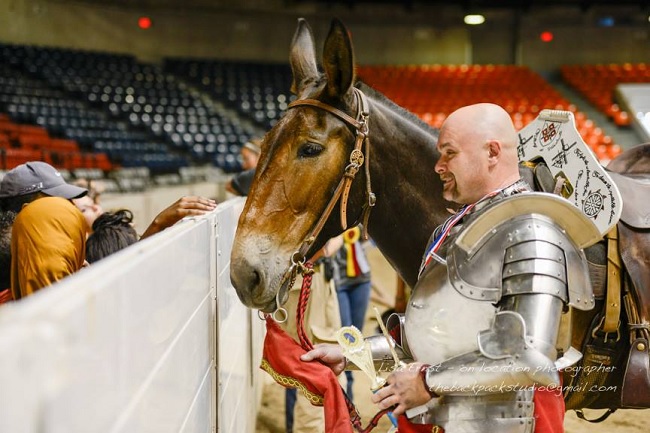
If you watch a competition joust you will often see many of the horses refuse to approach the tilt lanes. They know it’s work and scary. They don’t let their rider take a lance from the ground crew, they don’t stand waiting when the opponent isn’t ready and they run like a bat out of hell in the tilt and don’t stop safely at end of tilt, endangering themselves and the ground crew. Buttons and I aren’t led in, we approach on our own and stand. When I take the lance and signal my opponent ready by raising my lance she feels that and we take off at a canter. We stop nice at the end and take 2 steps backward to safely hand off the lance and walk out of lane. That’s her job and we practice it a walk, trot and canter in rope lanes at home till she gets it and is just shy of bored. If she does all that my job is easier, and I can focus on my job of getting my seat as we canter off, getting lance under arm firmly, lowering lance in time and on target to hit my opponents shield and break the lance. All of this in a couple seconds and in a suit of armor I cant see or breath or move as well in.
Not worrying about her doing her job frees me to focus on mine. That comes from tons of training and repetition. Once a mule learns something they usually remember it. But doing it in practice ensures they know what’s expected and don’t decide they will do it their own way. With mules you have to take your time and sometimes show them it’s safe, and use baby steps to raise the energy level so they stay comfortable. But usually you can always go forward even it’s a small step. Watch your mule’s ears and eyes they will tell you a lot. Wide eyes and ears back is scared mule. Flopping back and forth ears as they move is relaxed happy mule. Lips moving a lot or chewing the bit while they work is thinking or trying to figure out what you want. Slow it down or lower your energy level and come back in slower if you see those signs. And always try to end on a good note. Even if that note isn’t where you wanted to get to tonight, if you got a small step closer and they did that new step then praise them and end on that good note rather than a total fail where you both mad. Get the mule to trust you and give lots of praise and treats or loving when they get each baby step. Stay calm … they are smarter than horses and they know when you are mad or upset and they reflect that and feed off it. If you’re calm and full of praise they can get past their fears easier.
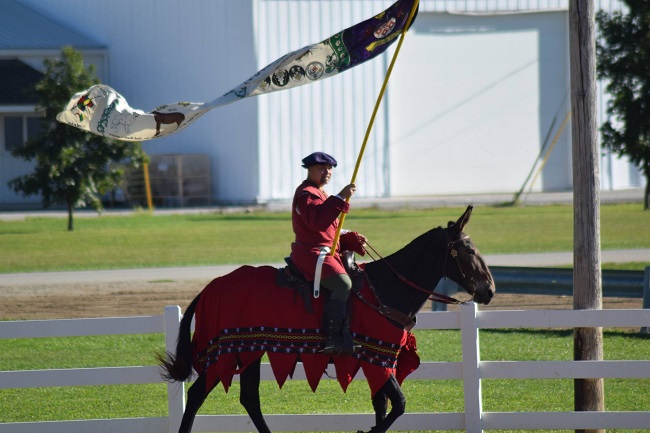
There are some mules that will never take to this high energy combat or games due to health or mindset. When asked what is the best breed of horse or mule to do jousting we say the ones who will do it. We have all different sizes and breeds of equines in jousting. It’s an equine whose mindset is good makes a good joust partner. They don’t choose to do this so you want to keep them safe and use a equine who is trained and “gets it”. There are some who even seem to enjoy it.
3 of our 4 mules have needed various amounts of the above to get them to do our stuff. We recently brought home Milly, a 12 year old 17 hand Belgium draft mule who used to be a cart mule with little trail riding saddle time. The day we brought her home, the friend who was to be riding this mule as my student in jousting jumped on her back and I on Buttons. We started circling each other with real low energy drills and when we saw no response we started upping the energy level and began playing slap tag. Slap tag is sort of like combat with no armor or weapons. Good way to introduce equines to getting close to another rider/horse. You chase each other trying to slap the other person in a high five or the back of the other riders head once you’re at full energy level. Still no reaction at all from Milly. This level of energy took a long time to get our other mules to. We picked up padded practice swords and hit each other softly. Nothing. Amazed, I said let’s go put armor on. Within 40 mins of bringing her home he and I were hitting each other with swords in armor. This mule didn’t care. With very little training she was ready for jousting. She stands fine, is a little lazy but will canter and figured out she slows and stops right after the hit. She needed no training at all to do archery. She is a little slow but does all our games and combat with little training. She just doesn’t spook and is a willing mule.
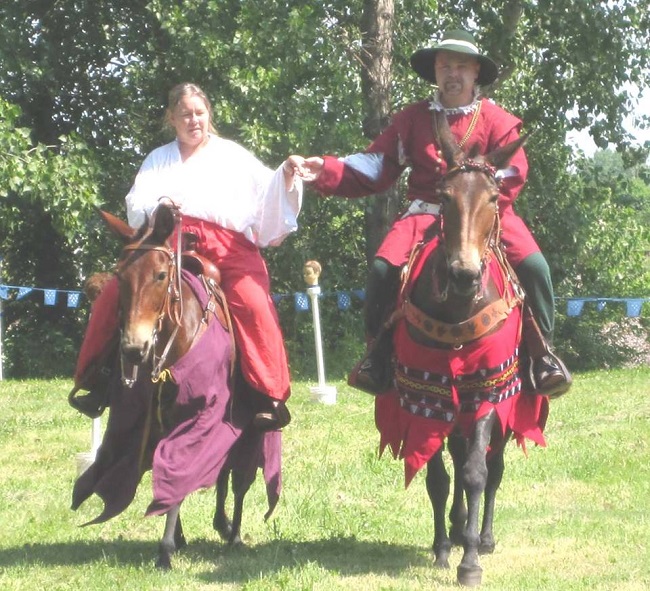
So we have had the wide spectrum from abused, to others needing some training, to lucky finds where they need little to no training.
I used to write for Mules And More magazine for many years about my adventures and misadventures. Buttons and I were on the cover last year after we won the Ohio State fair joust. Much of the above is in those magazines in more details. I really need to find time to write a story for the magazine about Milly the worlds 2nd jousting mule and her trip to the Ohio state fair for her 1st big joust.
You can read the article about Buttons’ first big joust at the Ohio state fair here. You can also view more photos on the website – although Dave warns that it has not been updated in a while!
UK readers who are interested in finding their local SCA group can find one here.
I have tried to credit all photographers, but if you see your image on here and it is not credited or if you would like it removed, then please let me know.
If you would like your mule to be featured here, then please contact me either via this blog, message me on my Mulography Facebook page, or email me at: herecirm (at) gmail.com. I would particularly like to hear from UK mule owners (purely because Mulography is about owning a mule in the UK), but am happy to take worldwide submissions!
